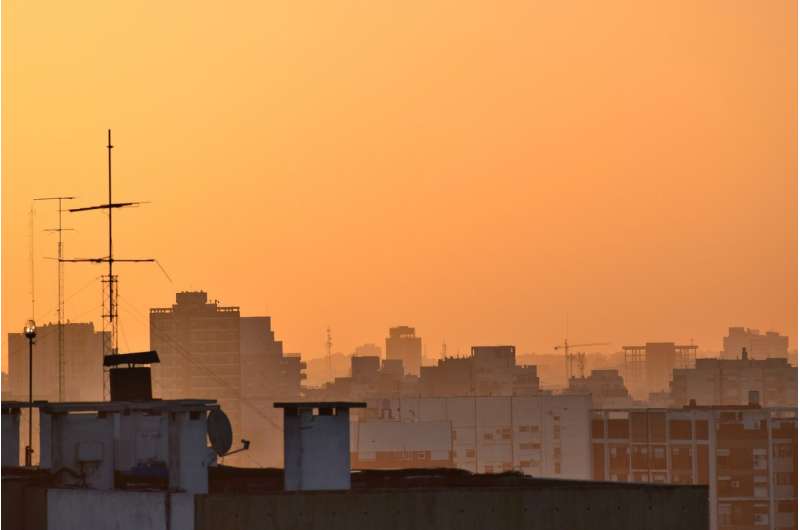Reduced traffic during lockdown did not improve air quality in urban areas as much as expected

Two studies led by María Morales Suárez Varela, group leader of the CIBERESP at the University of Valencia and professor of the Department of Preventive Medicine and Public Health at the academic institution, have evaluated the impact of mobility restrictions on air quality and polluting emissions, in Valencia and in three Italian cities. "The lockdown measures improved air quality in urban areas, but not as much as expected given the alleged contribution of traffic to ambient air pollution," explains Morales. "The restrictive mobility measures to limit the spread of COVID-19 provided a unique opportunity to improve our understanding of the impact of mobility on air pollution in urban areas."
In the first study, published in the International Journal of Environmental Research and Public Health, the research team studied whether there were significant differences in the concentration levels of suspended particles (PM10, PM2.5, NOx, NO2, NO and O3) between the restrictions period in 2020 and the same period in 2019. The findings showed that the lockdown measures were accompanied by a significant decrease in particle concentrations, even if there was variability in various areas of the city.
María Morales says, "The greatest reductions in the levels of PM10 and PM2.5 were observed for the Center of València, València Avenida de Francia and València Pista de Silla (all of the urban traffic type)". These solid or liquid particles of dust, ash, soot, metallic particles, cement or pollen, dispersed in the atmosphere (with a diameter between 10 and 2.5 micrometers (µm), one thousandth of a millimeter), are the most important in urban pollution as they can penetrate deep into the lungs and therefore pose significant potential health risks.
Furthermore, she adds, "there was a statistically significant decrease in NOx, NO2 and NO concentrations at the seven air monitoring stations, as well as O3 levels during the blocking period." In this case, it is a group of gases composed of nitric oxide (NO), nitrogen dioxide (NO2), their combination (NOx) and ozone (O3) that are corrosive to the skin and the respiratory tract. Prolonged exposure considerably reduces lung function, inflames the airways, and can potentially cause irreversible changes in lung tissue. In addition, it can affect the immune system and lead to less resistance to respiratory infections.
The other study evaluated the effects of the emissions that decreased during the COVID-19 period on air quality in three Italian cities, Florence, Pisa and Lucca, comparing the concentrations of PM10, PM2.5, NO2 and O3. "In this case we did not find significant reductions in the levels of suspended particles during the blocking period, except at a monitoring station in a high traffic area, which is considered a hot spot due to the consistently high levels recorded all over Tuscany," the authors explain.
On the other hand, the work reveals that the reduction in NO2 pollution levels, consistent with other studies, was statistically significant in all air monitoring stations in the cities used in this study, which shows a relevant relationship with the traffic volume. Finally, for the levels of O3 pollutants, the researchers did not observe a significant reduction during the blocking period.
"The lockdown measures improved air quality in urban areas, but not as much as expected given the alleged contribution of traffic to ambient air pollution. It must be considered, by the authorities, that the environmental response varies according to the dominant source of emission and the specific meteorological conditions, so it would be necessary to adopt holistic control measures to improve air quality in urban environments," adds Morales. "We believe that our results must be taken into account by policy makers to implement effective policies to counteract air pollution and place human health at the center of urban planning."
Exposure to ambient air pollution is one of the greatest health risks worldwide. It is estimated to be responsible for around 4.2 million deaths worldwide each year due to many diseases such as heart disease, stroke, acute and chronic respiratory diseases and lung cancer.
More information: Gabriele Donzelli et al, Relations between Air Quality and Covid-19 Lockdown Measures in Valencia, Spain, International Journal of Environmental Research and Public Health (2021). DOI: 10.3390/ijerph18052296
Gabriele Donzelli et al, The Effect of the Covid-19 Lockdown on Air Quality in Three Italian Medium-Sized Cities, Atmosphere (2020). DOI: 10.3390/atmos11101118
Journal information: International Journal of Environmental Research and Public Health
Provided by Asociacion RUVID





















